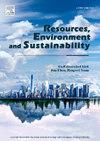Pollution characteristics of microplastics in greenhouse soil profiles with the long-term application of organic compost
Abstract
Organic composts are significant sources of microplastic (MP) pollution in soils, and their input is much higher in greenhouse agriculture than open-field agriculture. However, how long-term compost application affects MPs pollution in greenhouse soil profiles remains unclear. This study examined MPs characteristics in chicken manure compost and earthworms, exploring the long-term impacts of compost application on MPs accumulation and vertical migration in 0–100 cm soil depth through a 15-year greenhouse experiment. Microplastics abundance was 3965 items kg in compost, 191–248 items kg in compost-amended soils, and 2.73–4.52 items individual in earthworms from compost-amended soils; the latter two increased significantly with compost application and were significantly higher than unamended soils. Soil MPs accumulation from long-term compost amendment contributed 45.4% of the total. The proportion of MPs <2 mm in compost (49.7%) was less than in compost-amended soils (65.5%) and earthworms (65.4%). Microplastics size and abundance decreased with increasing soil depth. Microplastics polymer types and shapes in composts, compost-amended soils, and earthworms exhibited similarities, mainly including polyethylene and polypropylene fragments and fibers. Compost-derived MPs in soils exhibited complex weathering morphology and adhered to mineral colloids. Therefore, soil MPs originating from compost gradually weathered and degraded into smaller particles and migrated to deeper soil, maybe resulting in more serious ecological issues.


 求助内容:
求助内容: 应助结果提醒方式:
应助结果提醒方式:


